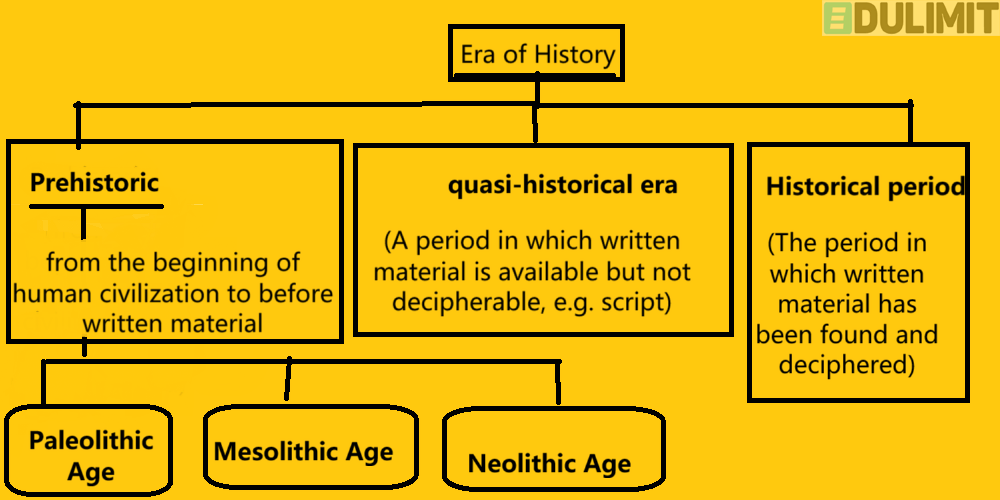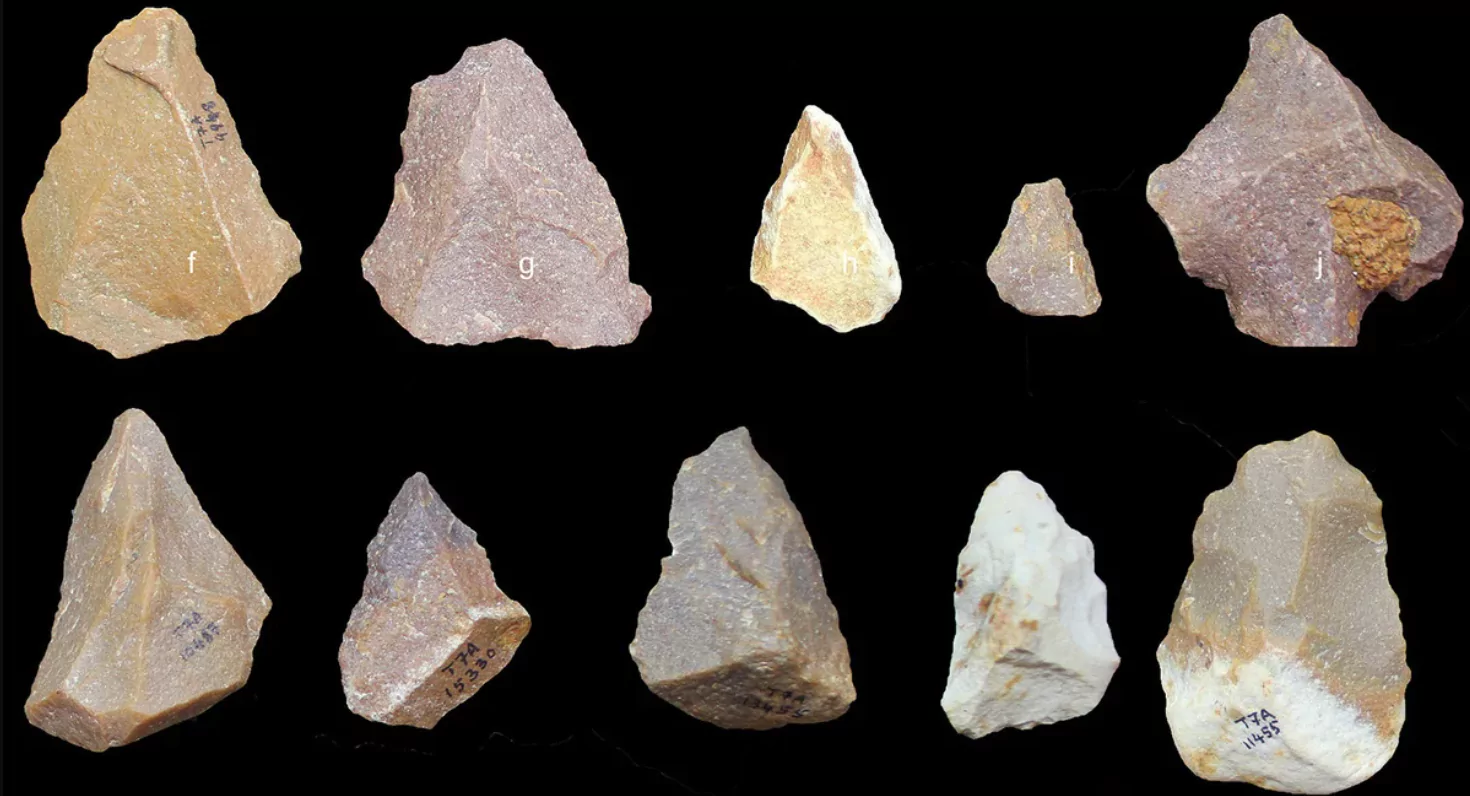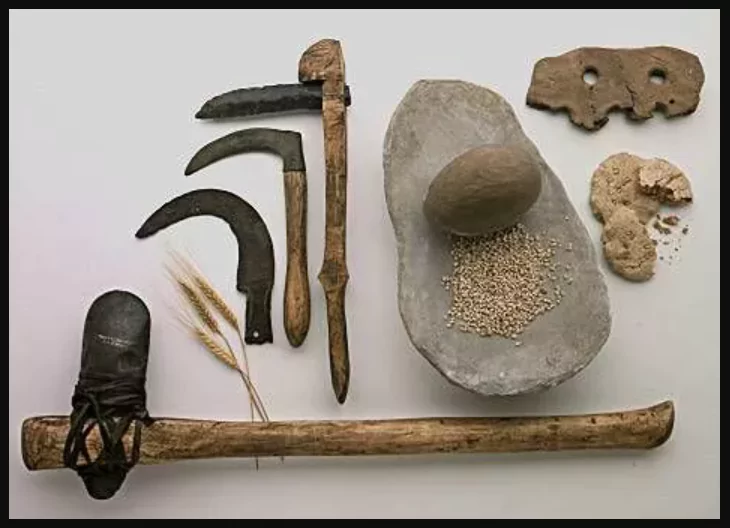The period between the beginning of human civilization and the advent of written records is considered a ‘prehistoric period’. Written historical material is unavailable from the prehistoric period. This age is mainly divided into three parts, namely-
- Paleolithic Age
- Mesolithic Age
- Neolithic Age
This article discusses the “Stone Age of India and Prehistoric Period“. This covers various periods of ancient history such as the Paleolithic, Mesolithic, Neolithic, and Chalcolithic Ages. Key points, notes and general knowledge from the Stone Age of India are important for UPSC Prelims, and other competitive government job exams.
| Period | Date | Characteristics | Important Sites |
|---|---|---|---|
| Paleolithic | 2.5 million – 10,000 BCE | Use of crude stone tools, hunter-gatherer lifestyle. | Soan Valley (Pakistan), Hathnora (Madhya Pradesh), Bhimbetka (Madhya Pradesh) |
| Mesolithic | 10,000 – 4,000 BCE | Microliths, domestication of animals, early agriculture. | Langhnaj (Gujarat), Mehran Garhi (Sindh, Pakistan) |
| Neolithic | 4,000 – 2,000 BCE | Polished stone tools, agriculture, settled life. | Mehrgarh (Pakistan), Burzahom (Kashmir) |

Paleolithic Age (2.5 million BCE- 10,000 BCE)
The Greek words “palaeo,” which means old, and “lithic,” which means stone, are the origins of the name “Palaeolithic.” Thus, the Old Stone Era is referred to as the Palaeolithic Age. Paleolithic men are also called ‘Quartzite’ men.
Race: It is thought that the Indians were members of the “Negrito” race
Duration: There is disagreement among historians regarding the exact duration of this era.
- India and other parts of the world differ with this period.
- This era is considered to be contemporary with the Pleistocene era.
- This period spans approximately from 2.6 million BCE – 10,000 BCE.
The Paleolithic Age is further divided into three periods – the
- Lower Paleolithic
- Middle Paleolithic
- Late Paleolithic.
The Lower Paleolithic Age
Duration: 2.5 million – 200,000 BC
Location: Kashmir region (formerly Swan region of Pakistan-Swan culture), Patwar Plateau, Shivalik Mountains in Himachal Pradesh, Hungsi Valley in Karnataka, Auripakkam near Chennai in Tamil Nadu, Didwana in Rajasthan, Nevasa in Maharashtra, Narmada Valley in Madhya Pradesh. Traces of ancient settlements have been found at Kurnool in Karnataka, Shanghai in Pakistan, Bhimbetka in Madhya Pradesh.
Human species: Homo habilis or Homo erectus.
Tools/Weapons: Mainly stone tools axes and ‘chopper’-type weapons. These weapons were made of pebbles or quartzite. These inferior heavy machines were the ‘core tools’ of the time. A hand ax weapon from about 5 to 7 lakh years ago has been found in the Pahalgaon region of Kashmir.
Food: People of this age were mainly food gatherers. Lived by hunting and gathering fruits. People of that time did not know about animal husbandry.
Residence: Had no permanent residence. Lived under the open sky or in natural caves.
The Middle Paleolithic Age
Duration: 200,000 – 40,000 BC
Location: Artifacts of weapons (mainly flake-type) found at Nevasa in Maharashtra, Didwana in Rajasthan (approx. 57000 years ago).
Tools/Weapons: The weapons were relatively light, and small but sharp in nature. Flake-type (light angle) weapons were among the most common in this era. The main weapons used in this phase were Knife (Blade), Bladelet, Burin (piercing weapon) etc.

Late/Upper Paleolithic Age
Duration: 40,000 – 10,000 BC
The predominance of the Negro ethnic group was one of the characteristics of the late Paleolithic period.
Tools/Weapons: The influence of knife-like implements made of flake continued. Blades and burins as well as tools for moulding, crescent-shaped tools and other small tools began to be used in the late Paleolithic phase.
Artifacts of this era have been found in India’s Andhra Pradesh, Maharashtra, Karnataka states.
Mesolithic Age 10000 to 6000 BC
The Greek terms “meso” and “lithic” are the origins of the phrase “mesolithic.” In Greek, “lithic” refers to stone and “meso” indicates middle. So Mesolithic means Middle Stone Age.
Duration: 10000 to 6000 BC
Major sites: A few tombs have been found at archaeological sites like Sarai Nahar Rai, Mahadha, Bagor, Adamgarh in MP, Langhnaj in Gujarat and Biharanpur in West Bengal, Bhimbetka caves, valleys of river Tapi, Sabarmati, Narmada etc.
Tools: Microlithic tools became widespread during this period. This period is therefore also called the ‘Microlithic’ period. As the tools were very small in size, they were used either embedded or attached to a stick-like object. Notable among these were bone blades, edged knives, quern-like materials (found in the Sarai Nahar Rai region).
People: The people living in the east of India were mainly of Mongol origin and the people living in the west were of Caucasian ethnicity.
Artifacts: Artifacts of this period have been found at Lakhanj in Gujarat, Patan near Chalisgaon in Maharashtra (28,000-year-old tools), Sarai Nahar Rai, Mahadha, Chopani Mando in Uttar Pradesh, Adamgarh in Madhya Pradesh, Bagor Pachapadra Valley and Sojat region in Rajasthan and Tineveli in the south.
Livelihood and Animal Husbandry: The main livelihoods of this period were hunting, animal husbandry, fishing, fruit gathering and agriculture (in the latter). They are believed to have existed from the bones of animals such as sheep, goats, deer, pigs, rhinos, elephants, turtles etc.
Info: There are indications of pottery during this period, but there was no use of the potter’s wheel. Fire was discovered in this period.
Neolithic Age 6000 to 2500 BC
The Greek words “neo” (meaning new) and “lithic” (meaning stone) are the origin of the name Neolithic. Consequently, the “New Stone Age” is referred to as the Neolithic Age.
Major sites: Sindh and Baluchistan (North-West India), Sangankalpa and Piklihal (Southern India), Bihar, Odisha and Assam (Eastern India), Mehergarh (7000 BC), Burzahom & Gufkral (Kashmir), Piklihal, Brahmagiri (Karnataka) Koldihwa and Mahagara, some parts of Belan Valley bear traces of the earliest Neolithic period in India.
Weapons or Tools: Weapons made of smooth and shiny stones were used as compared to earlier.

Artifacts:
- cottage construction.
- Improvement in subsistence agriculture and animal husbandry.
- Spinning wheel, earthenware and methods of making thread from cotton were invented.
- People became familiar with copper metal.
- No small arms of this period have been found in Kashmir.
- Burjahom in Kashmir is the first indication of burial practices of this period. Here it was customary to bury domestic animals with their masters.
- Evidence of paddy cultivation was found in Allahabad.
- Traces of the potter’s wheel and the use of fire were discovered at Mehergarh.
Info: Historian Gordon Childe called this period the ‘Neolithic Revolution’.
Info: The Neolithic period marks the beginning of the later Chalcolithic Age. The Chalcolithic Age belongs to the Proto-Historic Age.
Chalcolithic Age 2000-1000 BC
Duration: 2000-1000 BC
- Known as the Stone Copper Age
- A notable feature of this era was the use of both copper and bronze in the manufacture of utensils and equipment.
- From this time struggle for power and exploitation started among people.
- During this time people learned to use copper with stone and to mix tin with copper to make bronze.
Sites: Ahar & Gilund (Banas valley), Daimabad (Maharashtra), Malwa & Kayatha (MP), Sonpur (Bihar), Mahishdal (West Bengal), Songaon, and Nasik, etc.
Different cultures: During this period the Banas culture developed on the banks of the Banas river near Kathiabar. It is also called Ahar culture. The Kayatha culture developed on the banks of the Chambal River and its tributaries. The Malay culture (in Gujarat) developed along the banks of the Narmada and its tributaries.
Artifacts: Apart from this, copper-stone age artifacts have been found at Piklihal, Eran Nasik, Nevasa, Chirand in North Bihar, Dhulia in Maharashtra, Bangpur and Harappa.
Livelihood: Agriculture was the main livelihood during this period. Rice, wheat, tin or beans were among the crops produced.
Art and Machinery: Artifacts of weaving and pottery (red-black) have been found. Copper items, batali, harpoon, axe, etc. were notable among the implements.
Other features: People learned to build houses made of mud, wood and terra cotta. Bull and mother goddess worship was common.
Some notable cultures of the Chalcolithic Age and its periods
| Kayatha culture | 2000-1800 BC |
| Bangpur Culture | 1400-900 BC |
| Chirand Culture | eighth century AD |
| Ahar–Banas culture | 2000-1400 BC |
| Malay Culture | 1700-1200 BC |
Variation of primitive People
| Australopithecus | Period: Approximately 40 lakh to 30 lakh years ago. They could somehow stand on two legs. Their jaws were strong and well-formed. |
| Homo habilis | Period: Lived approximately 26 lakh to 17 lakh years ago. They eat fruits and raw meat. They used stones as weapons. They could walk. They lived in groups. |
| Homo erectus | Period: Approximately 20 million to 3.5 million years ago. could stand They lived in groups in caves. They used to hunt. They stood upright on two legs and were the first to learn the use of fire. They made handaxes as weapons. |
| Homo Sapiens | Period: Approximately 2.3 lakh years ago. They hunted animals in groups. Burned the meat and ate it. Animal skins were worn as clothes. They learned to make small and sharp weapons. |
Prehistoric Iron Age
- Duration: 1500 to 600 BCE
- The Vedic era, Buddhism, Jainism, and the arrival of the Aryans all flourished during the Iron Age.
- Mahajanapadas arose.
- Jainism, Buddhism flourished.